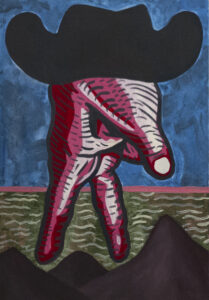
In rural Vermont, cultures are clashing over property lines. Landowners used to be generous with their property and their neighbors respectful of the privilege to use it. Land is changing hands now, and properties long open to the public are being posted against trespass. Many blame the influx of out-of-state “transplants,” who are unfamiliar of the ethic of publicly used private land. As a transplant myself, I was uneasy.
My deer had crossed onto the property of two life-long Vermonters, and I would have to ask permission to continue my search on their land. Slowly, I wound my way out of the woods and up a long gravel drive. Awkward and unsure of what to do with my gun, I approached a beautiful Adirondack house and knocked on the front door.
Dogs barked, the door swung open, and kind but cautious eyes met mine. I explained my predicament to Sharon, and she quickly granted permission to track my deer across her land. This permission came with a warning, though. Her husband, Michael, was also out hunting this morning. If our paths crossed, I would need to explain that I had spoken to her.
***
I lost the blood trail in a meadow, where the even carpet of oak leaves gave way to grasses that beads of red could not cling to. Dejected, I unloaded my gun and walked back through the field and up the drive. As I began to strip off my woolen field coat, a new voice startled me.
“What are you doing here?”
Michael’s brow was furrowed, and the gun in his hands was loaded. The gulf between us seemed vast. He, a true Vermonter; I, an ex-urban transplant. A seasoned hunter, comfortable in a tense moment with a firearm at hand; a novice hunter, uneasy about even purchasing a gun. My anxious mind leapt to other differences. The pick-up in their drive; the Subaru that had carried me to the hills outside of Burlington. By all appearances, Michael was a straight man; I, a queer one. Perhaps our politics clashed?
“I shot a doe on your neighbor’s land and tracked it onto yours. Sharon said it was alright for me to search for it here.”
Michael’s face hardened. “And you’re leaving empty-handed?”
I flushed with guilt. “I’ve been searching since eight, but I lost the trail in your pasture.”
To my surprise, Michael put down his gun and looked thoughtfully towards the field below us and into the tangled woods beyond.
“I know the deer around here pretty well” he said. “I’ll help you look for her.”
***
Michael’s eyes lingered over a thicket of buckthorn and red maple, just past the end of the blood trail. A wounded deer, he explained, will lie down in a thicket and become invisible. Our best chance of finding mine would be to walk the edges of each thicket near her trail’s end. If we could get her to stand, I would have a split second to take another shot before she fled.
Whatever our differences, the shared task on a shared landscape came first. We followed a slight depression downhill, circumnavigating each thicket with the slowness of herons scanning the water’s edge. Soon, the depression widened with collected water. Wounded deer, Michael told me, often follow drainages to larger streams where they submerge themselves to hide the scent of their blood, and then continue slowly downhill as long as their wounds continue to hamper them.
The prior tension between the two of us had lifted. Michael seemed thoroughly focused on the hunt and sharing his knowledge of the land and its deer. I soaked in his wisdom.
The drainage met a broad, stone-studded stream, and I found a fresh spot of blood at their confluence. The trail emerged from a swampy thicket—smaller and less frequent than before—and climbed a steep bank into the shelter of hemlocks. We appraised the path. When an injured deer’s blood flow diminishes, Michael told me, it can be a sign that the wound is not lethal. If the trail starts to gain elevation, the deer may be regaining strength after the shock of being shot.
In Michael’s estimation, my deer would likely make it. We talked over the merits of continuing the hunt, and I decided to press on, while Michael turned back for home. My chances of catching up to my deer were low, but, the knowledge I gained reading the landscape with Michael demanded practice. I decided I would follow the trail until I found my deer or lost it for good.
***
In the mid-afternoon, I walked out of the woods again—without my deer. But, as I stopped by Michael and Sharon’s house to thank them for their graciousness, it hit me that I was far from empty-handed.